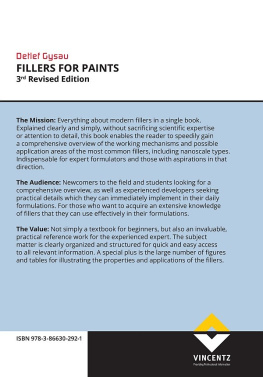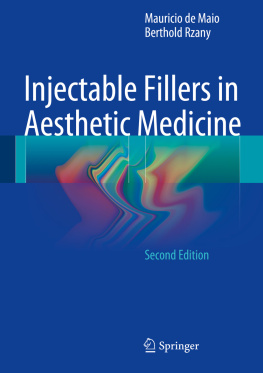Cover: Tiberius Gracchus/Fotolia
Bibliographische Information der Deutschen Bibliothek
Die Deutsche Bibliothek verzeichnet diese Publikation in der Deutschen Nationalbibliographie; detaillierte bibliographische Daten sind im Internet ber http://dnb.ddb.de abrufbar.
Detlef Gysau
Fillers for Paints, Fundamentals and Applications, 3rd Revised Edition
Hanover: Vincentz Network, 2017
European Coatings Library
ISBN 978-3-86630-525-0
2017 Vincentz Network GmbH & Co. KG, Hanover
Vincentz Network, Plathnerstr. 4c, 30175 Hanover, Germany
T +49 511 9910-033, F +49 511 9910-029,
This work is copyrighted, including the individual contributions and igures. Any usage outside the strict limits of copyright law without the consent of the publisher is prohibited and punishable by law. This especially pertains to reproduction, translation, micro ilming and the storage and processing in electronic systems.
Discover further books from European Coatings Library at:
www.european-coatings.com/shop
Layout: Schubert, Hamburg, Germany
eBook-Production:
readbox publishing, Dortmund, Germany
www.readbox.net
European Coatings Library
Detlef Gysau
Fillers for Paints
Fundamentals and Applications
3rd Revised Edition
For Jacqueline and Gian-Flurin and Mica-Ladina and also Rambo and Fuchur
There is no debt more pressing than the expression of gratitude.
Marcus Tullius Cicero
Foreword
The topic of fillers for use in paints and varnishes is an old one, so one might ask why there has been no comprehensive book on the subject to date. Could it be something to do with the earlier prevailing perception of fillers as cheap materials for bulking up profits? Are fillers even worth writing about? Certainly! The sheer number of mineral end-products, the frequently underestimated effort that goes into their manufacture, the testing done to characterise their diverse properties, their wide-ranging applications that is an awful lot of information to pack into a single work without diluting its focus.
Simply to consider the spectrum of professions involved in producing and using fillers geologists, mineralogists, mechanical engineers, machine operators, chemists, paint and varnish specialists highlights the extent of hidden technical activity. Fillers are instrumental in many properties of coating materials and films: their rheology, content of volatile organic compounds, solids content, brightness, opacity, reflectivity, adhesion, anti-corrosion characteristics, mechanical and chemical resistance the list goes on. The bottom line is, proper use of fillers calls for a great deal of knowledge.
The present book sets out to convey that knowledge in a straightforward and understandable manner, without compromising scientific objectivity and rigour. Special attention has been given to clear topical division and structuring, to facilitate finding pertinent information, fast. That having been said, the gamut of available fillers is so vast that there would be insufficient space to cover all the materials out there, some of them quite exotic. Instead, this book concentrates on fillers in regular current use, with numerous figures and tables to illustrate their properties and applications. All the same, this book cannot claim to be exhaustive in scope. Readers wishing to obtain further information and details will be served by the extensive bibliographic references provided.
This book is intended for anyone who is in any way professionally involved with fillers used in coating materials. Beginners and students will gain a comprehensive overview of the field, while experienced developers will find practical details of immediate relevance to solving their everyday problems.
In 2016 I was notified that also the second edition of Fillers for Paints is going to be sold out soon as well. I am more than delighted to learn that also the second edition found so many new readers. The continued interest in my book is also judged by manifold feedbacks which I received since 2006. All of them expressed to me their thanks and congratulations by filling a knowledge gap in raw materials for paints.
In particular, I appreciate that the book supports training for all different kind of groups, either in industry or science. The third edition allowed me to place small corrections, update market and filler data and add more sub chapters about new fillers and nevertheless an outlook about the future, for example sustainability and light weight fillers.
Detlef Gysau
Oftringen/Switzerland, January 2017


Contents

Introduction
1.1 Historical overview
Paints and varnishes have a history that goes back around 100,000 years, to the time when stone age peoples applied red body-paint as part of their cultish rituals[]. The first paintings on cave walls date back to the late Stone Age, their origins still somewhat shrouded in mystery. Many thousands of years later, in the 4th century B.C., the intermingling of ancient Egyptian and Greek civilisations brought remarkable developmental advances through Hagia Techn or Alchimia hallowed arts practiced by the high priests of the day. Their discoveries about the secrets of paint making remained influential well beyond the 16th century A.D. As the industrial revolution started in the 18th century, paints and varnishes came into widespread use for many different applications. Early 20th century triumphs of chemistry and technology in particular signified a clear departure from empiricism, to science.
The history of fillers can be traced back almost as far as paints and varnishes. Pigment analysis has revealed the presence of filler materials in early cave paintings[.
However, the first people to systematically use fillers for their cave paintings were the ancient Egyptians, and the Mediterranean cultures that succeeded them. The most frequent materials were chalk and gypsum, both white mineral fillers. Clays, or crushed mollusc shells, were also used on occasion. As history progressed, the ancient Greeks began using a mineral that was whiter still: white lead. Because of its rare occurrence in nature, they developed an intricate process to obtain the pigment synthetically. Contemporary demand for greater opacity and brightness evidently made the effort worthwhile. The Roman historians Pliny and Vitruvius respectively reported eight and five white pigments then in use, although only three were of real significance: the minerals melinum, paraetonium and cerussa (white lead).
During the period of the Roman Empire, there was a marked increase in the consumption of fillers, which were used in paints for murals, panels and frescoes. But filler production collapsed along with the Roman Empire, and artists subsequently resorted to local minerals. There were large chalk deposits in England, France, the Netherlands and Germany. Even in Spain, chalk grew prevalent under the name of Spanish white. In Italy, though, gypsum predominated. That was the situation until the 19th century, when the industrial revolution came into full swing.
The enormous increase in consumption of raw materials during the industrial revolution also brought a sustained rise in demand for fillers. Semi- and fully-automatic dressing processes were developed to address this demand, as well as to meet the steadily advancing requirements of industry. High-power machinery like crushers, grinding drums and classifiers came into use. The end of the Second World War brought even greater demand for fillers, which was a motor for further modernisation by the filler industry. The resulting technical developments led to ever-finer natural fillers and tailor-made synthetic fillers, some with surface coatings, see .
Next page












